|
|
|
|||
|
|
||||
|
|
||||
| The Smoky Addiction | ||||
|
|
HOME | SITE MAP | FORUM | CONTACT |
|
||
|
ABOUT | MOTORS | MODELS | ARCHIVE | HISTORY | STORE | FAQ | LINKS
|
|
|
|
|
|
|||||||||||||||||||||||||||||||||||||||||||||||||||||||||
|
The Smoky Addiction 4
(April 2005)
by Roger Simmonds Reprinted from SAM 35 Speaks, April 2005 First, can I remind readers that the FROG/Jetex Exhibition, May 22-23 at Solent Sky, Southampton, is less than a month away? Many distinguished modellers and aeronauts will be present; there will be displays of all types of Jetex and FROG kits, models and engines, and there will be photographs, video presentations and an extensive ‘swapmeet’. |
|
|||||||||||||||||||||||||||||||||||||||||||||||||||||||||
|
So whatever your interest, whether Jetex, FROG, or Penguin, or you have any interest in pre-war and early post-war modelling, there will be much to see and many people to talk to. I hope to see many SAM members at what promises to be the greatest ever celebration of Bill Wilmot’s and Joe Mansour’s achievements. Beginnings It’s hard to pin down when first I became enamoured of small model jet planes, but a discussion on the wireless about an important fifties’ document (recently released under the ‘Freedom of Information Act’) that specified the grades and texture of toilet paper in Government Establishments, jogged an early memory. Having built the basic structure of my first model jet, I looked around for a suitable covering material. I knew that proper flying models were covered in tissue, but I didn’t know what sort to use. Anyway, I did my best with what came to hand, and the model was duly completed. Though it was loosely based on the F-86 Sabre, it was my own design, and should, perhaps, have been called the ‘Bronco’. Once a discussion of all-sheet models has begun it is difficult to know when to when to stop, as there are so many vintage and classic designs worth resurrecting. For example, one of the first, if not the first, ‘independent’ Jetex plans to be published was Bill Dean’s Jetex 100 powered Jetwing (Model Planes Annual, Nov. 1948) [right]. With over an ounce of thrust and a span of only 19" it was a lively performer, and was flown (proxy, by John Wood) in the very first Jetex competition held at the 1948 Isle of Man Rally. It gained second place. Bill Dean’s flying notes reflect the novelty of Jetex propulsion at that time: “By taking off the turn, the Jetwing can be made to perform perfect consecutive loops. We have had as many as ten on a twenty second charge”. A still air duration of 1-1½min (in normal circling flight) was claimed. An enlarged version of the plan [right] can be downloaded from the Jetex.org website; if anyone would like a printed copy to build one for Rapier L4 or L2HP please let me know. Apropos of all-sheet models, I have to confess to some confusing nomenclature. Whilst I am very attracted to Skyleada’s ‘Silhoujettes’ designation, henceforth I shall use ‘all sheet models’ when referring to ‘all-sheet free flight duration sport models’, and ‘profile models’ when referring to ‘all-sheet scale models’. I’m not sure where this leaves models like Ray Malmström’s inspired Mooncrest biplane; perhaps ‘semi-profile’ is suitable, though it rather contradicts the definitions above! Chris Strachan’s L1 powered Mooncrest (right) will, like the Jetwing, fly very nicely in consecutive loops. I didn’t get to count them at Old Warden. Steve Bage has made good progress with his Yak 25 (right). Pete Smart comments: “It looks really tremendous and I'm sure the flight tests will be successful. You can't lose with all that sweepback and a fin like that. And the nose won't go as deep into a snowdrift as the Firebar’s would!” Following Terry Kidd’s advice, Steve is making the engine nacelles ‘knockoffable’. I’m not so sure this is a good thing; Pete’s A300 Airbus had engine pods held on with magnets, but they are fixed in his more recent Tupolev Badger and MiG 29. This makes a relaunch from a power-on ‘landing’ somewhat easier, as one doesn’t have to search for errant pods in the long grass! Or snow. Contrary to Terry’s expectations, models with twin engines are now quite common, at least on the building board, if not (as yet) on the flying field and in the air. Twins benefit greatly from a smooth and repeatable catapult launch: the cartoon on the right, which comes from a 1954 Top Flite ‘Jigtime’ kit, will help any reader still uncertain how to do this. Furthermore, if you would like to form a squadron and build lots of planes and have contests please let me know. The prize for a three-engined jet has, however, still to be claimed. I hope the example of Howard Metcalfe’s successful (profile) Starfighter will inspire someone to assay the Trident, an idiosyncratic French prototype of similarly intimidating configuration. The main propulsion was a cluster of SEPR rockets, but it was taken to altitude by two small Marboré turbojets. A 10-12" model could, therefore, have Rapier L1’s on the wing tips and an L2 in the fuselage. As further encouragement to an intrepid modeller, here is a three-view from William Green’s Jet Aircraft of the World (1955) [right]. I would advise a profile model to start with. Endings There has been some correspondence in Sam 35 Speaks about the recent, and, it would seem, final, demise of Keil Kraft. It is strange to think that ‘Jetex’ ceased trading more than thirty years ago. I have a memorandum from Bert Judge to the senior management at Sebel, dating from 1969, that not only throws some light upon this period, but also makes some interesting observations about aeromodelling in post-war Britain. It begins with a brief modelling autobiography, and then discusses in some detail Bert’s time at Wilmot, Mansour & Co. and Sebel. Bert, you will remember, rejoined Joe Mansour in 1952, and was responsible for a string of innovative designs from the SARO SA/1 [below right] and Voodoo onwards. Bert writes: |
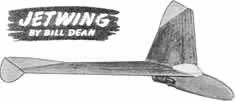 
- Model Planes Annual, 1949 (p. 44)
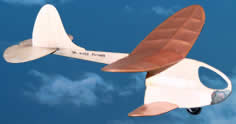 (des. Ray Malmström)
- Roger Simmonds

- Steve Bage
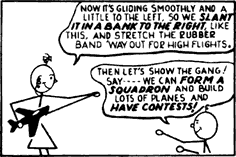
- Jigtime kit, 1954

- William Green, Jet Aircraft of the World, 1955
|
|||||||||||||||||||||||||||||||||||||||||||||||||||||||||
|
|
|
|||
|
“The Jetex business reached its peak in about 1950, but the model aircraft business as a whole had levelled off due mainly to noisy control line models being used in recreation parks and causing annoyance to residents. This resulted in all types of aircraft being banned from many open spaces which previously had been used for rubber and [i.c.] engined free flight model aircraft. “Up to 1953/1954 Jetex models were distributed by wholesalers, mainly Keil Kraft and Veron. Mr Mansour [then] set up his own sales organisation […] but sales fell rather than rose. In 1955 Mr Mansour had a serious illness and in his absence Mr Wilmot and his fellow directors decided to concentrate on pre-packaging […] Sebel bought the business and took over in January 1956. Mr Mansour acted as consultant and myself and other key personnel came with the company to continue its development. Mr Mansour had great hopes for Jetex as he felt that with the Sebel Sales Force sales would rise considerably. This was not realised and sales did not improve. “Under Mr Mansour’s direction we developed the first British vacuum formed flying model aircraft and extended the range of the balsa wood kits. We also attempted to get into the injection moulded kit business. The master models were made in brass by myself, but the castings were not as accurate as we were led to believe and had to be recut in the toolroom […] this meant that the kit price was much higher than similar models produced by other firms and sales suffered accordingly”. The successful development of the new propellant formulation, (which, according to the patents was still based on guanidine nitrate), was related in the (Jet)X Files, Dec. ’04. Bert discusses alternative pellets, made of ammonium nitrate and wood chip (cellulose) that were opportunistically marketed at this time: |

- Aeromodeller, June 1953 (p. 321)
|
|||
|
“During this time RipMax had developed a fuel [see advertisement right] which was cheaper than ICI’s and had also approached our American agents and persuaded them to retail the fuel in America. As this fuel burned at a higher temperature there was a danger that the standard aluminium motor cases would fracture, and we had a lot of complaints relating to the use of Ripmax fuel in Jetex motors. As our [Sebel] fuel also burned at a much higher temperature we had to develop steel motors and as our fuel was more stable and consistent Ripmax stopped manufacture when we introduced our own fuel. The method of manufacture using standard grinding, blending and pelleting machinery was designed by Mr Mansour, who then designed the special conveyor, drying oven and the lacquer coating spin dryer used for producing pellets. Production started in late 1959. “We then decided to make our own wick using a small prototype extruder. Mr Mansour, in conjunction with Mr Wykes of Sherwoods Paints, then worked out a formula and small quantities of wick were made and appeared to be entirely satisfactory. Experiments were still being carried out to improve the quality, but in the meantime Mr Mansour designed the wick-making machine in use today, and after testing and further modification [it] went into production in late1962. We had difficulty with the storage qualities of the first batches and a different plasticiser and stabiliser was introduced by myself, and after September 1963 we had very few complaints. “We were still continuing to make kits but sales did not improve, but tended to go the other way. I think one reason was that salesmen were toy salesmen and not model enthusiasts. The salesmen for all other model aircraft manufacturers are all modellers”. |

- Aeromodeller, July 1957
|
|||
|
A review of the period at Sebel up to 1969 follows; this was one of slow decline, despite the introduction of the vac-formed PAA-Loader powered Theron (right), two yachts, a catamaran and an ingenious hovercraft. Plans for a range of expanded polystyrene flying models were abandoned due to high tooling costs. Of special interest to us is the manufacture of 2½" pellets for Amateur Rocketry groups. Bert writes: “These were the only fuel approved by the Home Office for use in large rockets. They were entirely satisfactory and enabled the various groups to obtain excellent results.” Joe Mansour also worked on a new range of Jetex motors where the heat of combustion generated steam, so increasing thrust, but these were not entirely satisfactory or fully developed. Joe Mansour left the company in 1965. |
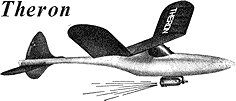
- Model Aircraft, Aug. 1961 (p. iv)
|
|||
|
Messrs Hobbies took over sales distribution of Jetex in early 1965 [see advertisement right]; Bert, however, continued to develop a new 3-wheel car and a speedboat for the 50C. Though these sold reasonably well, Hobbies’ estimated turnover of £30,00 per year was not realised. The last Jetex models Bert worked on (up to Sept 1966) were missiles for the 50C and PAA-Loader Motors. Bert’s historic memorandum finishes with a passage worth quoting at some length: “I think Jetex could certainly be resurrected as a business proposition starting with a completely new range of kits and models, but including the Jet car and Hydroplane, at competitive prices. As Messrs. Keil Kraft are taking over the sales and distribution of Jetex I would suggest a meeting with Mr Cosh to discuss the sales potential. I think between us we could decide on what types of models would sell and what the retail prices should be”. Alas, Bert’s vision was not achieved: it was not until the mid eighties that a Jetex revival, made possible by Roy Lever’s entrepreneurial efforts, was seen in the UK. This fizzled out eventually, but never became completely moribund. The scene was thus set for the joys and tribulations of Rapiers. |
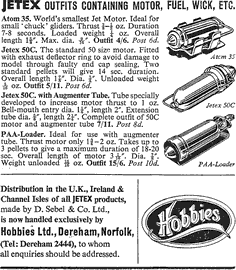
- Aeromodeller, Sep. 1965 (p. 407)
|
|||
|
Jet planes avec hélices? Leslie Moulster has kindly sent me details of a most unusual antique model that will gladden the heart of any Francophile: a rocket powered Blériot XI [right]. This curiosity, originally published in 14 Aéroplanes et Cerfs-volants, by a Monsieur C Berton in 1910, was unearthed by Vern McIntosh, who published the plan and a translation of the original monograph in a US specialist magazine, WW 1 Aero, (Vol. 122, 1991). |

- 14 Aéroplanes et Cerfs-volants, 1910
|
|||
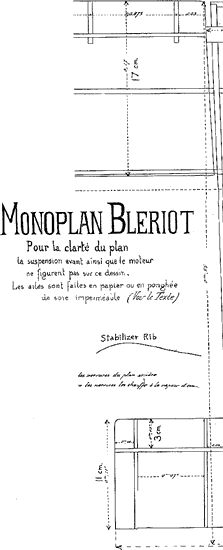
Monsieur Berton provided comprehensive instructions, including (uniquely for the time) making the 20cm by 3 cm rocket casing, complete with nozzle, and the propellant. This included potassium nitrate, sulphur, ‘rosin’ and (unwisely) potassium chlorate. The powder was simply tamped down with no attempt to shape the charge. These details are very reminiscent of those published by Lawrence Sparey more than thirty years later. I wonder: did Sparey have sight of M. Berton’s 1910 publication? I would strongly advise that any facsimile of the Monoplan Blériot is Rapier powered! Due emphasis to balancing, fore and aft and lateral is given in the directions for ‘tuning up’ (i. e. trimming). We then come to launching: “Place the aeroplane on a field, preferably with a little slope, but above all well smoothed, in a way to facilitate its starting and rising. Light the fuse and abandon the aeroplane; if the little machine is well-made it can fly more than 100 meters. […] The prototype, after having rolled perhaps half a metre, took off and at an average height of 2.5 metres covered a distance of 50 to 60 metres, alighting in a perfect manner.” |
|

- 14 Aéroplanes et Cerfs-volants, 1910
|
||
|
After giving instructions for disassembly of the model after flying, which I suspect are rather redundant (remember the potassium chlorate) and written, perhaps, with some Gallic irony, the author concludes: “We have nothing more, dear readers, than to thank you for your kind attention. If by any chance someone reproaches you because your aeroplane has no propeller, make one out of cardboard and place it at the front of the machine […] the recoil will get it in motion, and you thus complete the illusion of a veritable Blériot in full flight”. A present day Jet Jockey who is reproached because his aeroplane has no propeller might like to build Richard Crossley’s interesting Curtis XF-15C (right). This has a rubber motor and a Rapier L1: all things considered it flies really quite well. Tails of the unadeltarated |
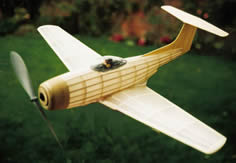
- Richard Crossley
|
|||
|
Terry Kidd and Charlie Jeffreys (who is responsible for the nice pun in the heading) have taken me to task on the subject of tailed deltas. Charlie writes: “The Dartex tail does indeed appear pointlessly vestigial. A trimming device perhaps? You may be familiar with the APS Sea King delta flying boat by Laurie Ellis, one of my favourite designs from around 1958 I think. Whether the tail is doing much I can't say, but it looks good and flies well. I presume it is closely related to the Mercury Aggressor by the same designer, which was also no doubt inspired by the Javelin.” Terry e-mailed: “By tailed delta you meant ‘T’ delta, because I know you haven’t overlooked the MiG 21, which must count as a genuine delta, and the Skyhawk and the F-16. The Eurofighter is also a delta, but they’ve put the tail at the wrong end. All those designers put the tails where they wouldn’t be blanked, but they did build deltas and gave ’em tails so I guess they are good for something.” We last discussed deltas in the (Jet)X Files, June ’03; I would refer interested readers to this and to the seminal article by Dr A M Lippisch [right] and Lawrence H Conover in Model Airplane News, Dec. 1951, and John Fozard’s article in the Aeromodeller Annual, 1953/54. By ‘tailed deltas’ I meant designs that fulfilled Dr Lippisch’s criteria but had a horizontal tail appended in what appears to be a ‘belt and braces’ afterthought. Unrepentantly, I maintain The MiG 21 and Douglas Skyhawk are conventional configurations with triangular wings! I suppose the Griffon II (Smoky Addiction, February 2005) is, like the Eurofighter, a delta and a canard. |
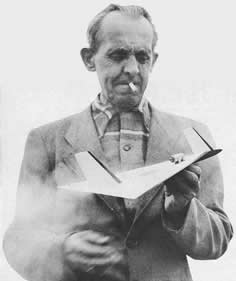
- Model Airplane News, Dec. 1951 (p. 16)
|
|||
|
Notwithstanding all this, Howard Metcalfe’s BAe Hawk, Richard Crossley’s Sukhoi Su-11, and Pete Smart’s SR 53 and FD 1, which could all be classified as ‘deltas, tailed or otherwise’, fly very well. Terry also drew my attention to Hot Toddy, E de H Rowntree’s curious semi-profile ‘Delta Quickie’ for Jetex 50 (Model Aircraft, Sep. 1953) [right]. Though this is a ‘true delta’ with a reflex wing, it is, (as was the early Wilmot Mansour Avro 707B, the first delta kit on the market), spoiled by large amounts of redundant dihedral. |
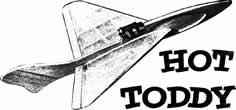
- Model Aircraft, Sep. 1953
|
|||
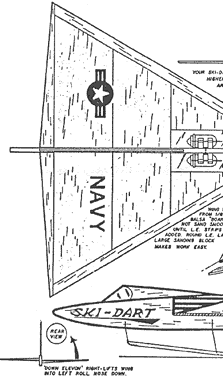
|
|
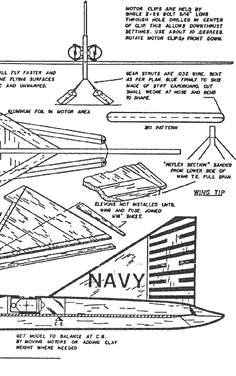
- American Modeler, Nov. 1957 (p. 29)
|
||
|
There is little more to say about this model, which is suitable for twin L2s, but the flying instructions do contain this interesting advice: “Get a straight line or a large circle. Note this turning, then always light up the motor that is on the inside of that circle first. Thrust forces act about the c.g. and this little trick will keep your model in a safe flight pattern”. Does this make sense? I would have thought that the motor on the outside of the circle should be the first “jet” to stop “blasting”. |
||||
|
|
||||
|
|
|
|||
|
|
|
|
|
|
|
|
Acknowledgements - Article: Roger Simmonds - Illustrations: Steve Bage, Richard Crossley, Bill Henderson, Roger Simmonds, MAAC archives via Bill Henderson |
|
|
|
|
ABOUT | MOTORS | MODELS | ARCHIVE | HISTORY | STORE | FAQ | LINKS |
|
|
Terms of Use
|
Queries? Corrections? Additions?
Please
contact us.
|
|